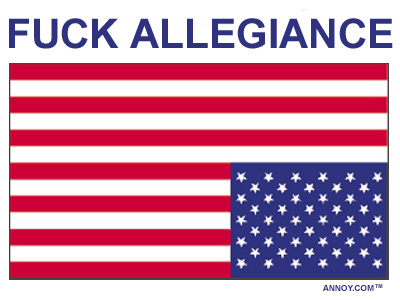 Will the Pledge of Allegiance be banned from government institutions? It's far too early to know. Already, politicians are mobilizing to overturn or circumvent last Wednesday's controversial 2-to-1 decision by the U.S. Ninth Circuit Court of Appeals, which declared the Pledge unconstitutional. Even the court itself has since decided to take things slowly. Will the Pledge of Allegiance be banned from government institutions? It's far too early to know. Already, politicians are mobilizing to overturn or circumvent last Wednesday's controversial 2-to-1 decision by the U.S. Ninth Circuit Court of Appeals, which declared the Pledge unconstitutional. Even the court itself has since decided to take things slowly.
Although it is highly premature to write an obituary for the Pledge, it is not too early to note the irony: Many, although by no means all, of the Pledge's defenders fancy themselves as keepers of the country's best traditions of liberty and justice. But their allegiance to the Pledge may be misplaced.
The Pledge was authored in August 1892 by socialist Francis Bellamy, who saw it as a means of eradicating individualism, mandating the loyalty of immigrants (especially Catholics), and inculcating conformity and unswerving nationalism through the government-school system. Fierce and devoutly religious supporters of government schools, both Francis and his cousin Edward Bellamy wrote in great detail how to create a centrally-planned economy similar to the present military-industrial complex in the U.S. As John Baer notes in his book, THE PLEDGE OF ALLEGIANCE, "In 1892, Francis Bellamy was
also a chairman of a committee of state superintendents of education in the National Education Association. As its chairman, he prepared the program for the public schools' quadricentennial celebration for Columbus Day in 1892. He structured this public school program around a flag raising ceremony and a flag salute -- his 'Pledge of Allegiance.'"
According to Bellamy's procedure for the Pledge:
"At a signal from the Principal the pupils, in ordered ranks, hands
to the side, face the Flag. Another signal is given; every pupil
gives the Flag the military salute -- right hand lifted, palm
downward, to a line with the forehead and close to it. Standing thus,
all repeat together, slowly: 'I pledge allegiance to my Flag and the
Republic for which it stands; one Nation, indivisible, with Liberty
and Justice for all.' At the words, 'to my Flag,' the right hand is
extended gracefully, palm upward, towards the Flag, and remains in
this gesture till the end of the affirmation; whereupon all hands
immediately drop to the side."
With the rise of fascism in Europe, the salute was later replaced by
placing one's right hand over the heart, a practice not fully adopted
in most government schools until 1950. In addition, in 1924, at the
behest of the American Legion and the Daughters of the American
Revolution, "my flag" was replaced by "the Flag of the United States
of America," for fear of conflicting loyalties among immigrants.
And in 1954 when the Pledge acquired the words "under God" at the
urging of the Knights of Columbus -- the phrase that the Ninth
Circuit panel found unacceptable -- the Pledge's revisers were
cashing in on the Cold War fear of an atheistic communism -- a
concern not shared by America's deistic founders (Jefferson, Madison,
et al.) nor of the residents of the post-Soviet world. As John Baer
states, "The Pledge was now both a patriotic oath and a public
prayer."
Like the title of the book by Francis Bellamy's more famous cousin,
utopian socialist Edward Bellamy, the Pledge's defenders today may
indeed be LOOKING BACKWARD.
But they are looking in the wrong place.
There is much to be said for instilling in youth a respect for the
best ideas from the past, and for that, there is the Declaration of
Independence and the U.S. Constitution -- two documents that come
closer than any others in the history of government to articulating
the purpose of, and providing the blueprints for, a free society --
which deserve a special tribute this July 4th.
Carl P. Close is Academic Affairs Director for The Independent Institute and Assistant Editor of The Independent Review. His articles have appeared in The New York Times, San Francisco Chronicle, Consumer Finance Law Report, and other publications. He is also Editor of The Lighthouse, a weekly e-mail newsletter of The Independent Institute.
This piece originally appeared in the July 2, 2002 issue of The Lighthouse. Republished with permission.
|




